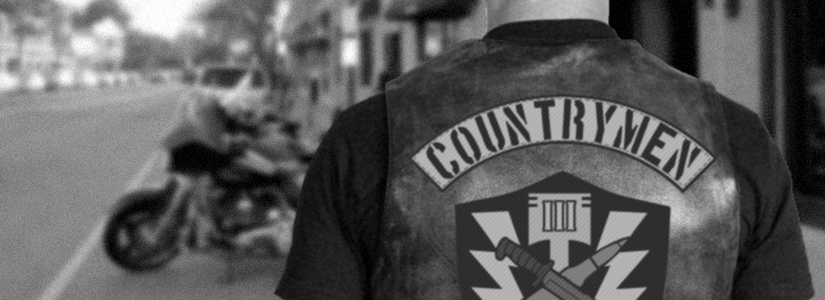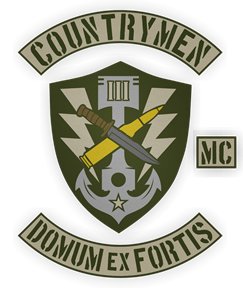Skip to content

- Leave your ego at home.
- Arrive at the departure point on a mechanically well-maintained motorcycle, with good tires, a full tank of gas and a grateful attitude.
- If the Road Captain or command team officer determines your bike is unsafe to ride, you are grounded from riding to meet the club or with the club until it is made safe and approved by the Road Captain or command team officer.
- Notify the Ride Leader of any concerns: mechanical, emotional, skill level, etc.
- When riding in formation, the first rider shall position himself at the front-left of the formation, and all other members shall align in a tight staggered formation.
- Ride with the pack; give enough room so the man in front and rear can maneuver, but keep the formation tight enough so vehicles do not get the impression they can cut into the formation.
- The rear-most rider, or “Tail-Gunner”, shall position himself centered on the formation with additional space between he and the last regular formation rider.
- During a regular lane-change maneuver, the Tail-Gunner shall block traffic from the rear, then all riders to his front shall change into his lane.
- In an urban environment, tighten the formation to mitigate the risk of riders getting cut off at yellow lights.
- On highways, country roads, and other rural environments provide additional “working space” around you and other riders; one to two bike lengths between bikes depending on the speed and technical difficulty of the road.
- Ride leaders shall establish a tail-gunner for each formation; he should be an accomplished rider who also knows the route.
- Keep the rider behind you in view. If he disappears for more than a minute, signal the formation and stop at the nearest safe place and wait until the rider reappears. If after waiting for 2 minutes the rider does not reappear, send the tail-gunner back along the route until the rider is found and render whatever aid is appropriate or possible. If the problem cannot be solved within 5 minutes, the ride leader will make the call to regroup with the lost rider, or take the body on to the destination.
- If the main body proceeds to the destination, a new tail-gunner for that formation must be established.
- For riders that are lost or have mechanical problems, simply park the bike in an obvious and safe position, hopefully where you last saw the preceding rider, and wait for someone to come back for you; most likely the tail-gunner will come upon you and can assist you.
- If you are required to stop due to being lost or having mechanical problems, park your bike in an obvious and safe position, ideally at or near you last saw the preceding rider, and wait for someone to come back for you.
- Do not pass members of the group while en route, except after breaking the formation to proceed to a different destination than the formation.
- Never pass other riders within the formation; always use an adjacent lane.
- Inform the Ride Leader of any plans to depart from the group before the ride is completed. Tap your head and wave out of the group when you need to break formation.
- Be prepared to ride 5 miles over the speed limit in town, and 10-15 miles per hour over the speed limit on highways. The ride leader sets the pace of the formation; follow or fall out.
- Stay in your track; inside to inside, outside to outside. All prospects and members must be able to make a turn or change direction without entering into the track of the staggered rider behind him.
- Wheelies and other stunts conducted in or around the formation are not acceptable.
- With very little exception, conduct group lane changes using the tail-first method: Ride leader signals lane change, all riders pass signal to the tail-gunner who changes lanes first blocking all incoming traffic, then all riders change lanes from rear to front.
- The ride leader shall inform the group of imminent departure, and all riders shall get ready ASAP. The ride leader should be the last to be ready to roll. When he leaves, the formation leaves. Be ready, or be left behind.
- If a cage needs in to get on or exit the highway, don’t be a jackass. Slow down, and let them on/off, then rejoin the group. The riders in front will slow and wait for y’all to catch up.
- When traveling outside the regular DFW area for an extended period of time while wearing colors, inform your Chapter President as far in advance of the travel as possible where and when you intend to fly colors so an effort can be made to respectfully inform the dominant club for that area.
- When approaching another club on a multi-lane highway, if they are in the left most lane, do not pass them on the right. A club riding in the left-most lane is claiming that highway. If they are in the middle or right lane(s), it is okay to pass on the left, but do not “buzz” the formation, or pass at a very high speed. If the club is obviously a senior-tier club, ride leader may opt to wait to be waived on anyway; ride leaders should use a common sense approach.
- When approaching another club on a single-lane or two-way highway, do not pass unless waived on to pass by the tail-gunner. If approved, do so with extreme caution and do not “buzz” the formation. If not waived on to pass, do not pass.
- Whenever possible, ride with at least two people understanding that people have to split off at some point to head to their respective destinations. There is strength in numbers, and the CVMC should be a “hard target”.
- Establish and communicate chapter-wide hand-and-arm signals. Every rider in the formation has the obligation to pass on the hand-and-arm signals so that it reaches all the way back.
- A prospect or member not wearing a kutte shall not ride with the club.
- Members will encourage skill improvement, responsible riding, and riding enjoyment and discourage aggressive, competitive, and potentially self-destructive riding behaviors. Wheelies and other stunts conducted while riding in a group are prohibited.
- When riding to a multi-club event, always attempt to rally off site first, then ride together to the event. Avoid however possible arriving at a multi-club event alone. If it can’t be avoided, informing your SA.

